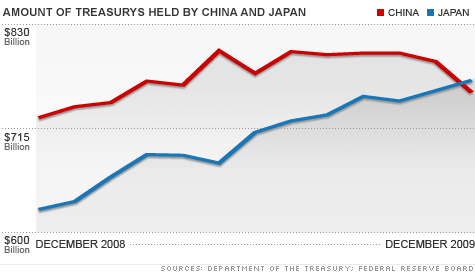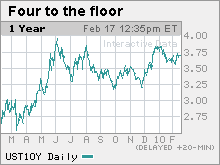 China's been reducing its exposure to U.S. debt in recent months. That would be more worrisome if not for the fact that Japan has been on a bond buying binge.
China's been reducing its exposure to U.S. debt in recent months. That would be more worrisome if not for the fact that Japan has been on a bond buying binge.NEW YORK (CNNMoney.com) -- What's it going to take for long-term Treasury yields to climb again?
Most experts believe that the rate on the 10-Year Treasury is likely to climb above 4% by the end of the year.

 |
| Long-term bond rates have remained in a narrow range for the past few months. Some think the 10-Year yield will eventually pass 4% again but won't go much higher than that. |
If the economy shows more signs of steady, albeit unspectacular, growth, it makes sense for bond investors to start focusing more on inflation concerns. That should mean a sell-off in long-term bonds and corresponding rise in their yields. (Bond prices and rates move in opposite directions.)
In addition, foreign investors appear to be growing increasingly wary of how much debt the U.S. has accumulated in order to pay for stimulus and various bailout programs. That should also, in theory, put upward pressure on rates.
"Rates are going to drift higher over the course of the year for two reasons. The Treasury has massive financing needs because of the deficit and the economy is continuing to improve," said David Joy, chief market strategist with RiverSource Investments, a money management firm based in Minneapolis.
But the news on Tuesday that China reduced Treasury holdings by $34 billion in December, a move that allowed Japan to overtake China as the largest foreign owner of U.S. debt, didn't have the impact you'd expect. Bond prices rallied, pushing the yield down to about 3.66%. (Rates inched back up over 3.7% Wednesday afternoon, though.)
On the one hand, investors may have brushed off the China news because the data is relatively "old." Just because China sold in December may not mean it is still doing so now.
"The Treasury data is always a look in the rear view mirror. The Chinese may had planned to diversify in December since the dollar was just starting to strengthen," said John Stoltzfus, senior market strategist with Ticonderoga Securities, an institutional trading firm in New York.
But there is what could be considered a worrisome trend.
Since peaking at $801.5 billion in debt holdings last May, China has reduced its exposure to U.S. debt in four of the past seven months. Of course, it's silly to suggest that China has been massively dumping Treasurys since it still has $755.4 billion in debt holdings.
Chinese officials have vocally expressed displeasure with U.S. fiscal policy numerous times over the past year or so. And that makes sense: If the U.S. has to keep issuing debt, that should reduce the value of China's holdings.
"Supply issues with Treasurys because of the rising deficits would push rates higher. That is a real concern," said Jonathan Adams, adjunct professor of finance at New York University.
But Adams quickly added that as long as the debt crisis in Europe remains in the headlines, the U.S. will look attractive to China and other foreign buyers. After all, Japan has been consistently increasing its Treasury holdings over the past year.
"To the degree that U.S. debt is still viewed as very secure, the level of demand for Treasurys should remain at a high level," he said.
Adams also said he does not think China is really trying to send the U.S. a message to get its fiscal house in order. Instead, China is probably simply looking to do what any smart investor does: hedge its bets.
"Any investor that owns as much as China does is very likely to buy and sell at different times. What they've sold over the past couple of months is not significant compared to their total holdings," Adams said.
Stoltzfus agreed, adding that if China wanted to sell Treasurys to punish the U.S., it would find itself with few attractive alternatives now that "the euro is no longer everybody's darling."
Add all that up and it seems as if a big bond bloodbath and spike in long-term rates probably isn't on the horizon. Comments from a bunch of Fed heads Tuesday may also have helped to keep bonds from selling off.
Minneapolis Fed president Narayana Kocherlakota gave a fairly gloomy assessment for the job market, saying that the unemployment rate would likely still be above 9% by the end of 2010.
That's important since many think that the Fed would like to raise interest rates soon, but won't risk doing so as long as the job market remains anemic.
"With the weak labor market, there is enough of a cushion against inflation that the Fed will probably stay on hold for the remainder of the year," Joy said.
And even inflation hawk Thomas Hoenig of the Kansas City Fed took a recent turn being dovish -- kind of.
At the Fed's most recent policy meeting last month, Hoenig voted against the Fed keeping language in its statement that suggested the central bank should keep rates "exceptionally low" for "an extended period."
But in a speech Tuesday, Hoenig seemed to suggest that interest rates may not head higher soon. And he did not sound too thrilled about that fact, lamenting that the Fed may "succumb to political pressure" and "keep rates low" because of the government's massive debt levels.
So if the Fed holds pat, will long-term rates rise a bit? Probably. And that should lead to a so-called steepening of the yield curve. That could be a problem since it may cause a runup in mortgage rates that are influenced by the 10-year Treasury.
Still, Stoltzfus said he thinks rates may only move as high as 4%. Joy also said he is not forecasting a dramatic increase. He thinks the 10-year yield might hit 4.25% by year's end.
That would probably not lead to a big enough jump in mortgage rates to put what looks like a nascent recovery in the housing market in jeopardy.
"I don't expect rates to go wildly higher. And even if mortgage rates drift up with the long end of the curve, mortgage rates are still attractive on a historical basis. They're just not as attractive," Joy said.
-- The opinions expressed in this commentary are solely those of Paul R. La Monica. ![]()



| Overnight Avg Rate | Latest | Change | Last Week |
|---|---|---|---|
| 30 yr fixed | 3.80% | 3.88% | |
| 15 yr fixed | 3.20% | 3.23% | |
| 5/1 ARM | 3.84% | 3.88% | |
| 30 yr refi | 3.82% | 3.93% | |
| 15 yr refi | 3.20% | 3.23% |
Today's featured rates:



| Index | Last | Change | % Change |
|---|---|---|---|
| Dow | 32,627.97 | -234.33 | -0.71% |
| Nasdaq | 13,215.24 | 99.07 | 0.76% |
| S&P 500 | 3,913.10 | -2.36 | -0.06% |
| Treasuries | 1.73 | 0.00 | 0.12% |
| Company | Price | Change | % Change |
|---|---|---|---|
| Ford Motor Co | 8.29 | 0.05 | 0.61% |
| Advanced Micro Devic... | 54.59 | 0.70 | 1.30% |
| Cisco Systems Inc | 47.49 | -2.44 | -4.89% |
| General Electric Co | 13.00 | -0.16 | -1.22% |
| Kraft Heinz Co | 27.84 | -2.20 | -7.32% |
|
Bankrupt toy retailer tells bankruptcy court it is looking at possibly reviving the Toys 'R' Us and Babies 'R' Us brands. More |
Land O'Lakes CEO Beth Ford charts her career path, from her first job to becoming the first openly gay CEO at a Fortune 500 company in an interview with CNN's Boss Files. More |
Honda and General Motors are creating a new generation of fully autonomous vehicles. More |
In 1998, Ntsiki Biyela won a scholarship to study wine making. Now she's about to launch her own brand. More |
Whether you hedge inflation or look for a return that outpaces inflation, here's how to prepare. More |